Illinois Crop Update – July 25, 2025
Steve Brand– Commercial Agriculture Specialist
DeKalb County
Soil Conditions: Near Normal
Its another hot week upon as a heat dome settles down on the Midwest as a whole. July so far has brought 3.5 – 5 inches of rain depending on the area you are in, excluding Will county which is still in a somewhat severe drought. Northwest Illinois is on pace for historical averages and enjoying a great growing season. South of Chicago and some of the suburban counties are drier than normal and continue to be in either a D1 or D2 drought. Corn planted on April 25th should expect to be around 1500-1600 growth degree units on the season.
Corn is mostly tasseled across the region. R1 to R2 blister stage and looking very healthy. With the rain the past couple of weeks, disease has finally arrived across northern IL. I confirmed Tar spot in Dekalb, Kane, McHenry and Lake counties this week with strong suspicions it is in DuPage and other nearby counties. All plants I scouted that had 1 or 2 lesions on the leaf below the ear leaf. This far into the season most fungicides are already being applied and should protect the plants through the end of the season. Scouting will tell you if additional sprays are needed, but anything after R3 is generally not recommended. Gray leaf spot has been working its way up corn plants as well.
Soybeans are progressing along. Disease is low and they are moving into R4 or 3/4 inch pods. We are still generally stunted in northern IL from the early droughts and later emergences, but the soybeans overall look healthy. Not much to say overall on the soybeans as pods are setting and filling.
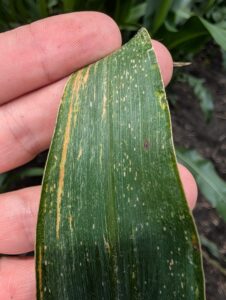
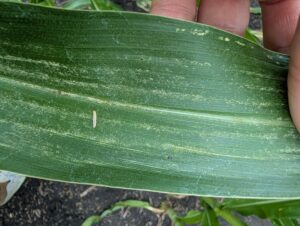
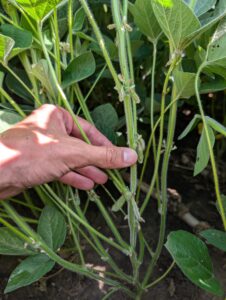
Russ Higgins – Commercial Agriculture Educator
Grundy County
Soil Conditions: Moderately Dry (soil is dry, plants may be browning or stressed, water bodies are low)
Despite nearly an inch of precipitation over the weekend many grass areas have yet to come out of dormancy in areas that were very dry. Tar spot confirmation frequency is increasing in Northern Illinois Counties and merits attention. Isolated Southern rust infection was also detected this week in the area. Dr. Boris Camiletti addressed Southern Rust identification and management in a July 19th Bulletin article. In R3 (milk stage) corn scouted Corn earworm (CEW) was found. Generally, it is not an issue in dent corn but can be for sweet corn. The female CEW moth lays individual eggs, preferentially on fresh corn silks. After hatching in 2-5 days the larvae will move to the tip of the developing ear to begin feeding. Once inside the ear there is no effective control for the pest.
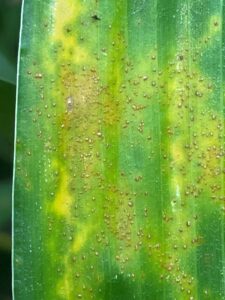
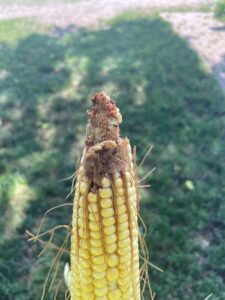
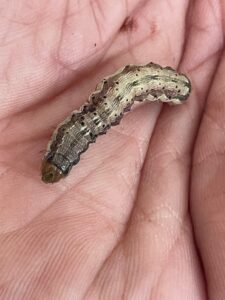
Reagan Tibbs – Commercial Agriculture Educator
Logan County
Soil Conditions: Near Normal
Last weekend’s 3+” of rain gave a much-needed boost for crops across Logan County. While some areas may still exhibit signs of heat stress, most fields appear strong and healthy. Corn at the University Research Plot in Hartsburg and across much of the County is in at least the R3 “milk” stage, with some in the R4 “dough stage. The same can be said of soybeans, with nearly all fields having pods at various stages of development. Cooler temperatures and more rain in the next week will undoubtedly be welcome.

Talon Becker – Commercial Agriculture Specialist
Coles County
Soil Conditions: Near Normal
With frequent rains over the past couple weeks, topsoil moisture remains adequate and crop health is looking good across Coles County. Full-season soybean fields ranged from R3 (beginning pod) to R5 (beginning seed). I saw minimal disease in the soybean fields I surveyed. Minor Japanese beetle feeding was common in fields visited, although it was generally contained to the uppermost leaves and <5% defoliation, overall. The couple double crop soybean fields I found were in the V3-V4 range, with growth just starting to poke through the wheat stubble. Corn fields were generally around the R2 (blister) stage, with some stragglers still in R1 (silk) and a few early-planted fields reaching R3 (milk). I saw minimal foliar disease in the corn fields I walked into, although some common diseases such as northern corn leaf blight, Physoderma brown spot, and common rust are starting to show up in the lower canopy.
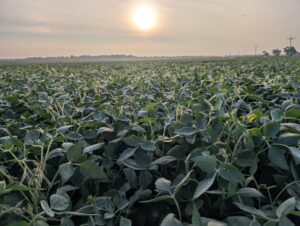
![Corn ears at R2 (blister) [left] and R3 (milk) [right] growth stages](https://farmdoc.illinois.edu/wp-content/uploads/2025/07/7.25.25Becker2-300x174.jpg)





